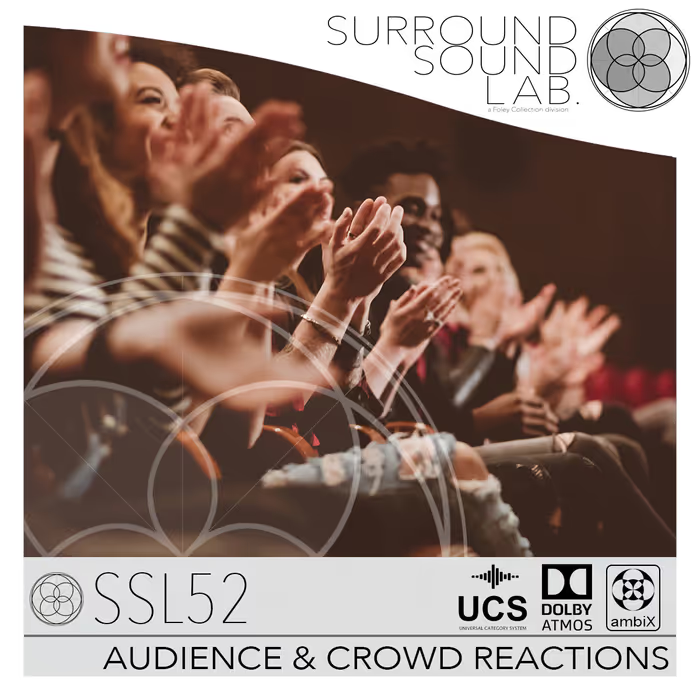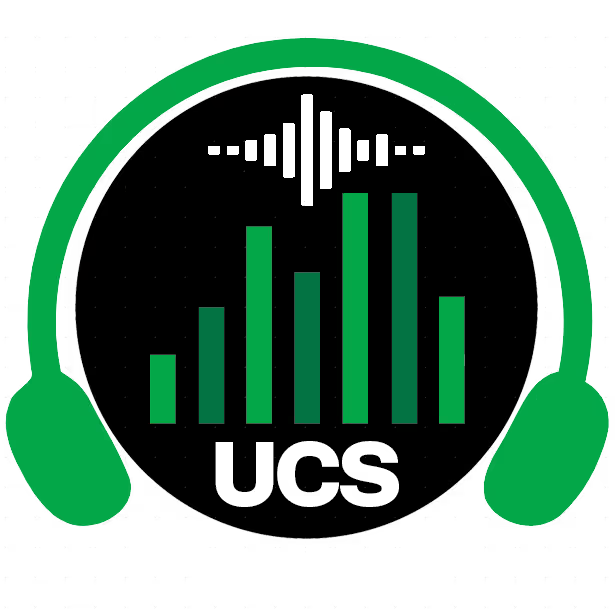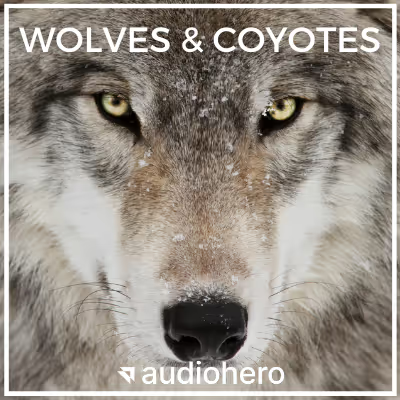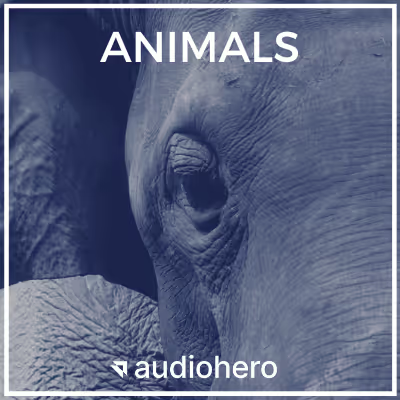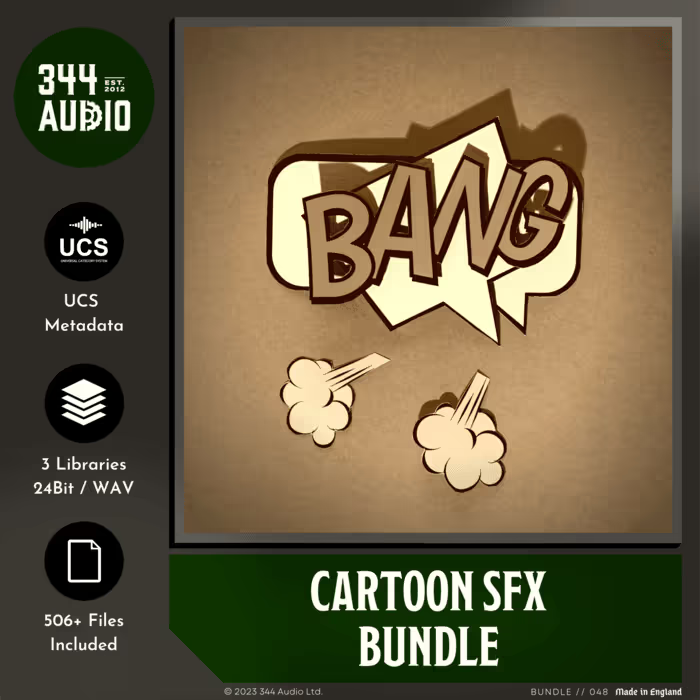Forget the flu; this winter it’s all about Star Wars fever. And it’s hitting hard across all media — The Mandalorian series on Disney+, Star Wars: The Rise of Skywalker in theaters, and Star Wars Jedi: Fallen Order on gaming platforms.
On Star Wars Jedi: Fallen Order, getting the iconic film sounds (like lightsabers, blasters, and ship sounds) to play interactively required asset sharing, creativity, and problem solving. Plus, there was a wealth of new locations, characters, weapons, and modes of transportation not seen in the films that required unique sounds that fit the Star Wars universe.
Here, the sound team at Respawn Entertainment — Nick Laviers (Audio Director), Harrison Deutsch (Dialogue Lead), Kevin Notar (Senior Sound Designer), Nick von Kaenel (Sound Designer) and Stefan Kovatchev (Sound Designer) — talk about their overall aesthetic approach and working with legacy sounds, how they designed new characters like BD-1, new creatures, and new locations, how Foley helped to sell the plethora of Cal’s acrobatic movements, how they handled the vocal processing and alien languages, and so much more!
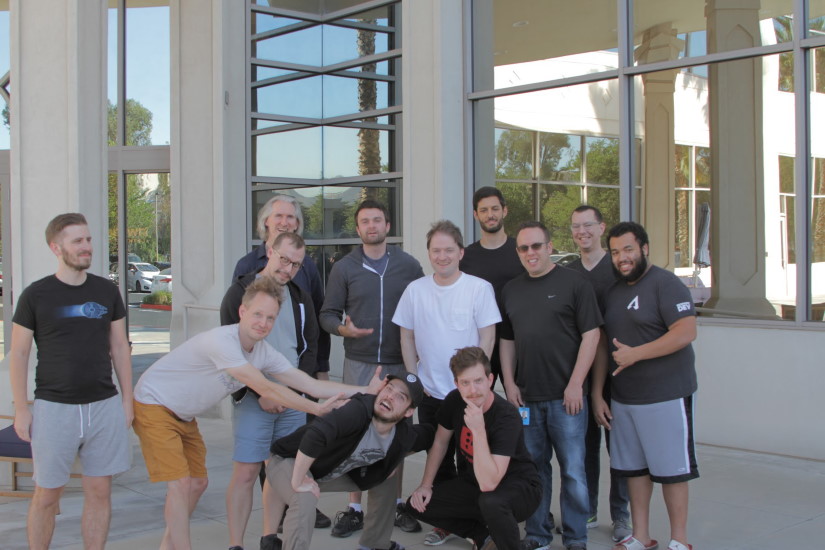
This is Respawn’s first Star Wars game. Did you get any sounds from the Star Wars brand, such as lightsabers, blasters, droids, ship sounds, or other legacy sounds? What were some guidelines when designing new sounds for this IP?
Kevin Notar (KN): Yeah of course! Via Lucasfilm we got access to the familiar Star Wars sounds we needed to make the game. Many people are playing this game because they want a Star Wars experience, so we wouldn’t want to radically change things like the E-11 blaster rifle or the TIE fighter, since they are iconic and fans want to hear them.
Our goal was to create our own identity within the sonic galaxy of Star Wars
However, this is not to say that we didn’t stylize audio for our game. Our goal was to create our own identity within the sonic galaxy of Star Wars, and to aid in this, we created three pillars to act as guidelines:
Gameplay Feedback: Adding audio tells to help the player in combat, as well as reinforcing player input by creating clean and punchy ability SFX.
Unique character: Recording unique sounds that would be iconic to Star Wars Jedi: Fallen Order. Part of any Star Wars story is encountering sounds you’ll never forget.
Realism: Focus on immersion in our ambience and planet sounds, to enhance the experience of exploration.
For the alien languages, how did you come up with the different alien dialogue lines? Can you walk me through your process from writing to casting to pronunciation and performance?
Harrison Deutsch (HD): The dialogue writing for the different aliens was a mix of work done by our narrative team and improvisation by our actors. For example, the alien scrap workers you hear at the beginning of the game originally only had lines written for them in English.
I had each actor assigned to the roles do a pass in English as written and then improv a pass, making up an alien language. We used the tone of the written English lines to drive the improv performance.
Our Narrative Lead, Aaron Contreras, requested some alien versions to mix and match in the game. I had each actor assigned to the roles do a pass in English as written and then improv a pass, making up an alien language. We used the tone of the written English lines to drive the improv performance. I specifically chose actors for our aliens that I knew had a strong knowledge of how Star Wars alien languages sound.
What was your approach to vocal processing on the non-human NPCs? And your vocal processing on the stormtroopers?
Mattia Cellotto (principal sound designer at Criterion) sent me videos daily of all the cool stuff they were doing — like recording all of the already processed dialogue through a variety of different stormtrooper helmets, and ramping up the processing intensity when the Second Sister becomes more aggressive during the boss fight.
KN: Regarding dialogue processing, a lot of this was in collaboration with EA’s Criterion studio in the UK. The Second Sister was the first voice they worked on and, initially, they had sent over a bunch of concepts for the Second Sister’s helmet processing, and while those concepts had cool elements, it didn’t quite feel right.
As inspiration for them, I did a mock up in Reaper, sent them the session along with the chain so that they could work off it, and from there, they took it to the next level. Mattia Cellotto (principal sound designer at Criterion) sent me videos daily of all the cool stuff they were doing — like recording all of the already processed dialogue through a variety of different stormtrooper helmets, and ramping up the processing intensity when the Second Sister becomes more aggressive during the boss fight.
Criterion ended up doing the SFX for the Second Sister along with a variety of other processing chains for other droids in the game. It was a great collaboration!
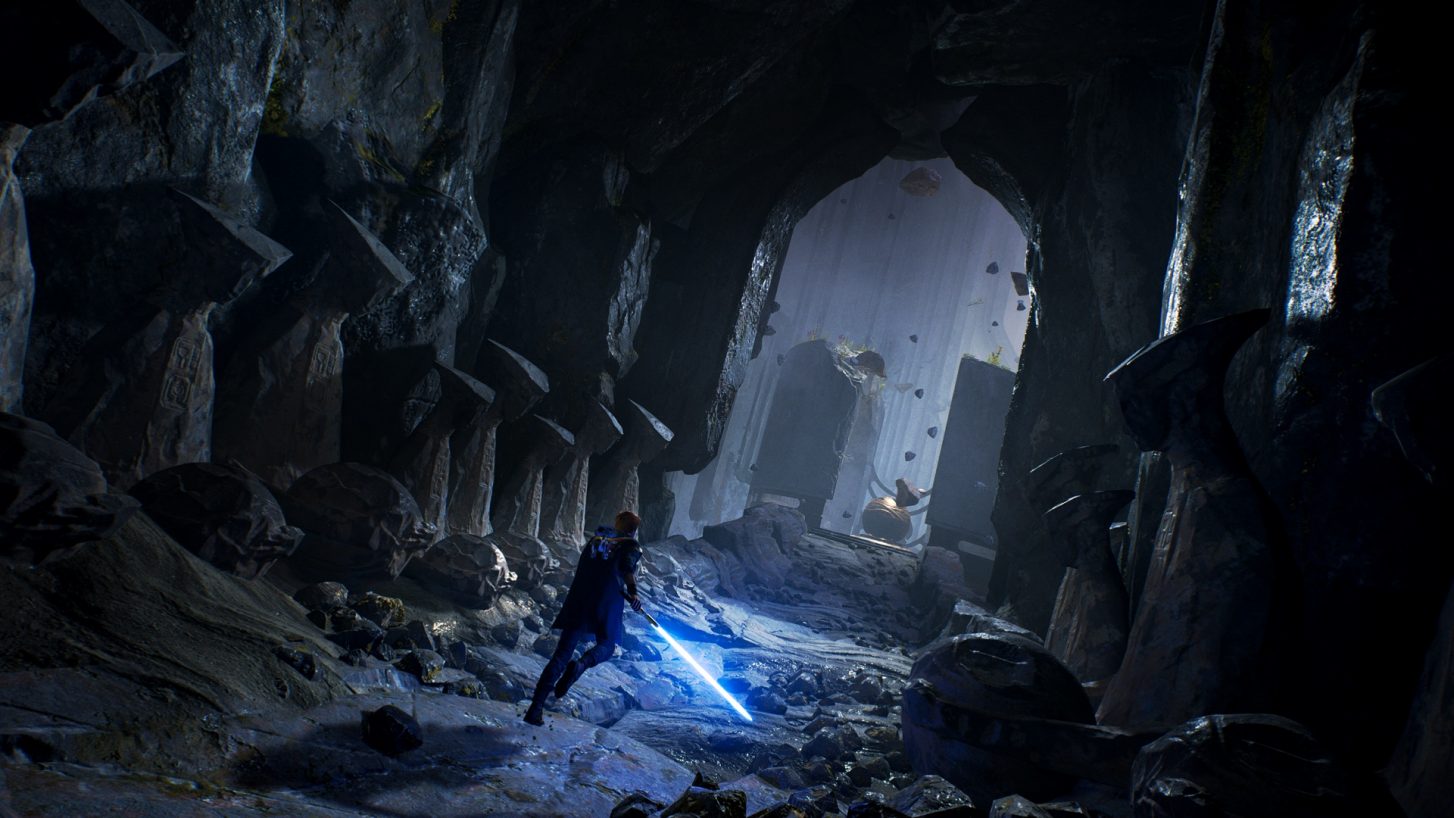
How did you create the sounds of BD-1?
Nick Laviers (NL): There are two sets of BD-1 sounds: first is his ‘voice’ created by Ben Burtt and second is his movement sounds which we created here at the studio.
Originally BD-1 looked different and had R2-D2’s voice pitched up as a placeholder. This served us well at the beginning because of the immense range of emotions R2-D2 already had and pitching them up added extra cuteness given that BD-1 was always smaller and more agile. It was clear to us at the beginning that we wanted Ben [Burtt] to do what he did for R2-D2 and Wall-E for BD-1 and create another lovable and iconic droid voice.
By the time we started working with Ben, BD-1 was visually as everyone knows him now and Animator Laure Retif had already done a fantastic job bringing him to life with animations. Laure made a video of BD-1 doing a range of different moves in a story setting to inspire Ben and he got to work creating different approaches to BD-1’s voice — some focusing on bleep-bloops like R2-D2, some on more vocalized tones like Wall-E and some incorporating less familiar palettes of sounds like little fragments of machine noises and more exotic synth sounds.
Ben didn’t reveal to us exactly how he made the range of sounds he gave us. You should contact Ben and see if he can give you his side of the story! One thing I’m certain about though is that he performed the vocal sounds, just like he did for Wall-E. That’s what puts the heart into it!
…[Ben Burtt] performed the vocal sounds, just like he did for Wall-E. That’s what puts the heart into it!
We ended up using an amalgam of several of Ben’s options. We fed our sonic choices back to him and he started working them up into the cute, playful voice we’ve come to know and love. Nick Friedmann on our dialogue team took the utterances Ben created and further refined all of BD-1’s expressions in-game. For most things, we gave Ben videos of moments in the game to work with because of his film background. But we had way more BD-1 moments in the game than we were able to have Ben score for and that’s where Nick [von Kaenel] came in. He was able to really refine the sound, playing it in-game and iterating to get the feel perfect.
Nick von Kaenel (NVK): I had the opportunity to work on BD-1’s movement and ability sounds. The movement sounds are made up of tiny servos and mechanical sounds from objects you might find around your house such as drills, cameras, nail guns, and more, plus small metal Foley sounds, all layered together. I did some light processing for some of the sounds to give it the Star Wars feel. When choosing sounds, I tried to focus on sounds that fit the character of BD-1, looking for cute squeaky sounds with personality.
BD-1’s footsteps are actually the same assets as Cal’s footsteps, just pitched up an octave in Wwise with a bit of EQ and layered with a metal sweetener.
BD-1’s footsteps are actually the same assets as Cal’s footsteps, just pitched up an octave in Wwise with a bit of EQ and layered with a metal sweetener. Going up exactly one octave worked well because it meant that metal footsteps with a pitched tone stayed consistent and felt believable for both Cal and BD-1.
Aesthetically, what was your approach to the UX sounds? How specifically did you create those sounds?
NVK: The first UX sounds I made were for the holomap. For that, I took a bunch of the original Star Wars hologram and telemetry sounds and processed them a bunch using plug-ins such as GRM Tools Warp/Shift, Soundtoys Crystallizer, D16 Antresol, and MeldaProduction MFreqShifter/MComb. I have a large effects rack in Ableton that I like to run source through when I’m in experimental mode and it’s great for quickly making a bunch of original sounds I can cut together later.
The aesthetic approach for the real-world UX sounds was basically the classic Star Wars tech sound, just with new content. I felt that using the original sounds and morphing them helped to give the sounds I made some special character while still sounding fresh. Especially with sci-fi sounds, you can get away with a lot of wild processing and still have usable material to work from.
See and hear a section of in-game footage from Jedi: Fallen Order
Early on in the project when I had some spare time, I started building up a library of UX sounds in the general style of Star Wars. This turned out to be incredibly handy later on. I gathered a bunch of source from synths, the Star Wars library, or other sound libraries and threw it in Twisted Tools S-Layer in Native Instruments Reaktor. From there, I generated a bunch of interesting combinations. I saved the ones I liked and made it into a library I could pull from later. I did this a few times with different material.
As the UI of the game started to take shape, the next thing I looked at was the Skill Tree, which you access while Cal meditates. Here, the art style and the concept seemed to call for something different than you normally hear in Star Wars games. Stefan [Kovatchev] was handling the sound for all Cal’s flashbacks and since entering this zone would be in a similar vein, he did the sound for entering this area. I picked up on a lot of the tones he was using and let it influence the rest of the UX sounds.
It was a lot of trial and error trying to nail down the right aesthetic, but it kind of ended up being this hybrid magic/sci-fi palette of washed-out metal and tech tones along with some classic chimes/sparkly textures.
It was a lot of trial and error trying to nail down the right aesthetic, but it kind of ended up being this hybrid magic/sci-fi palette of washed-out metal and tech tones along with some classic chimes/sparkly textures. I also incorporated a bit of fantasy-style bassy impacts to help sell important moments. I avoided bright, glitchy, noisy sounds as much as possible and tried to incorporate as many rounded morphing tones as I could to make the sounds more memorable and mysterious. This ended up informing the aesthetic of the Pause Menu and various pop-ups as well, which felt thematically similar to the Skill Tree.
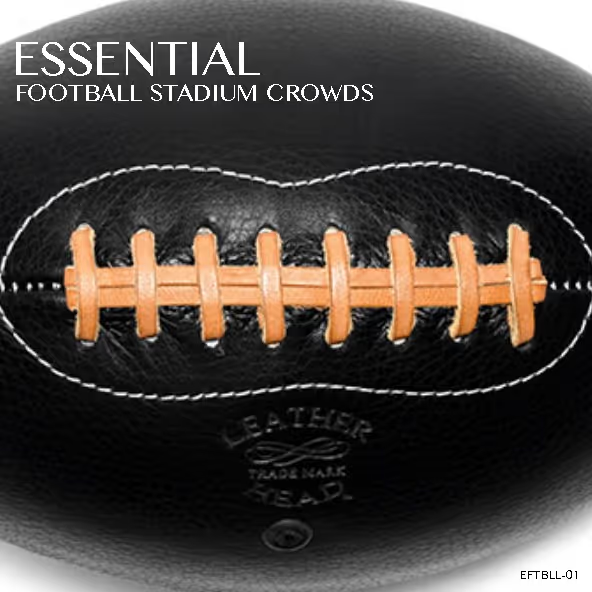 Football Stadium & Crowd Ambiences – Cheers, Goals, Whistles & Field Action for Film, TV & GamesTsunami Sound Wave45,00 $
Football Stadium & Crowd Ambiences – Cheers, Goals, Whistles & Field Action for Film, TV & GamesTsunami Sound Wave45,00 $
Something I learned while making these sounds was that you want to be picky with which layers get sent to reverb.
The plug-in I used the most for these sounds was actually iZotope RX Spectral De-noise. It helped me isolate interesting tones from a variety of source material that I could use as the core of each sound. Zynaptiq Wormhole was also great for taking normal tones and transforming them into otherworldly material. Once I had the tone I wanted, I would add the noise elements necessary to sell the tactile feedback. Something I learned while making these sounds was that you want to be picky with which layers get sent to reverb. Sometimes, if you send a noisy click to a reverb, it can completely cover up the interesting part of the tail, but other times you might want the noise to ring out a bit. There are a lot of tiny edits that can go into a UX sound and, especially for the shorter sounds; you need to try it out in-game to really know if it feels right.
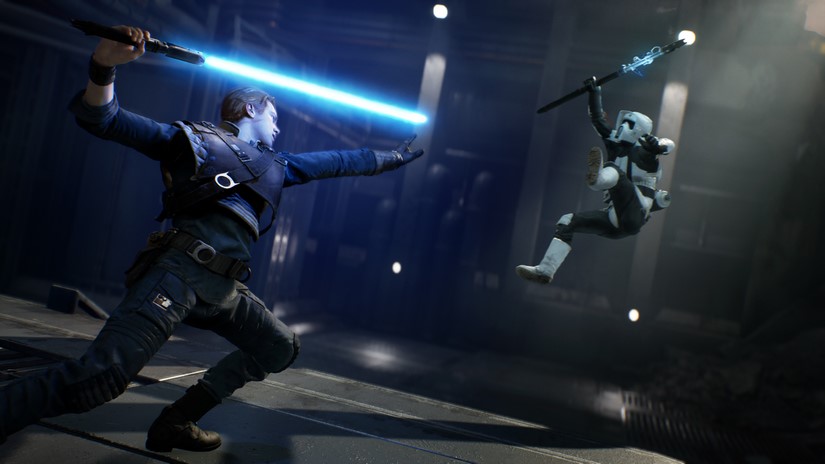
How did you make the lightsaber sounds reactive to the player’s movements? What were some of the sound assets you used? Was there in-game processing? What were some of your challenges in making the lightsaber such a satisfying sound?
KN: The lightsaber is driven off of relative velocity, and is comprised of three layers: low, medium, and high. You mostly notice the effect this implementation approach gives when you’re using it as a flashlight to see dark areas, i.e. not fighting.
However, relative velocity alone was not enough to sell the movement. The game is far from a simulation, and trying to solely rely on relative velocity gave us many issues. Because of this, all of the combat-focused lightsaber swings are manually tagged on animation.
For different colors, we add real time processing to both the loop and the swings, and the processing intensity is also driven by relative velocity.
For different colors, we add real time processing to both the loop and the swings, and the processing intensity is also driven by relative velocity. The three effects are Wwise Tremolo, Wire Flanger, and Wwise Guitar Distortion. Each saber color has a different setting, and the effects are manipulated in different ways depending on that color.
Another thing we added were a variety of different intensities for hits, blocks, and parries, based off of how hard you, or the enemy opponent is swinging (if a lightsaber-user). There are five intensities for this.
The biggest challenge was the amount of work required to tag everything! Oscar Coen (Technical Sound Designer) was in charge of that, as well as editing the original lightsaber swings so that they sync well with the animation. He also took on the lightsaber hits, and did a great job on them! Striking the droids with the lightsaber is super satisfying.
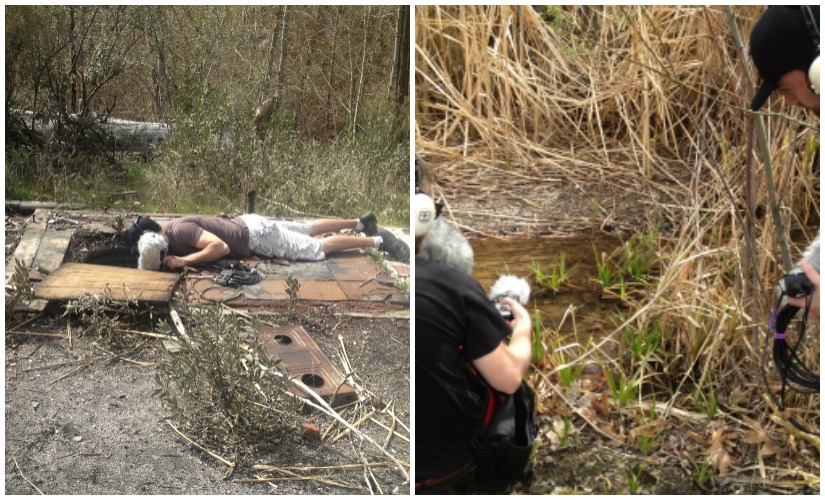
Any fun recording sessions for this game? How did those sounds work into your designs for the game?
KN: Early on, following Ben Burtt’s example, we set out to record a variety of sounds. We weren’t searching for the biggest and baddest sounds, but rather for unique sounds that hide in our everyday lives.
We weren’t searching for the biggest and baddest sounds, but rather for unique sounds that hide in our everyday lives.
The most distinctive place I visited was the California Science Center. I recorded many of the gizmos that they had in there, and used them throughout the game.
In my kit for this specific shoot, I had an Neumann RSM 191, Sennheiser MKH 416, and a Barcus Berry contact mic, which I ended up using the most because it was pretty noisy there.
NVK: We did a pretty free-form experimental field recording trip early on in the project, going out into nature and seeing what we could find. We brought along the microphones Kevin mentioned as well as an Ambisonic mic since we were looking into Ambisonics at the time.
We did a pretty free-form experimental field recording trip early on in the project, going out into nature and seeing what we could find.
One of the cooler sounds we recorded with the Ambisonic mic was a starter pistol fired between two cliffs, which I could rotate later to make an interesting IR with a staggered delay from front to back. We also went to a movie ranch and played around with props, just gathering anything we thought sounded cool.
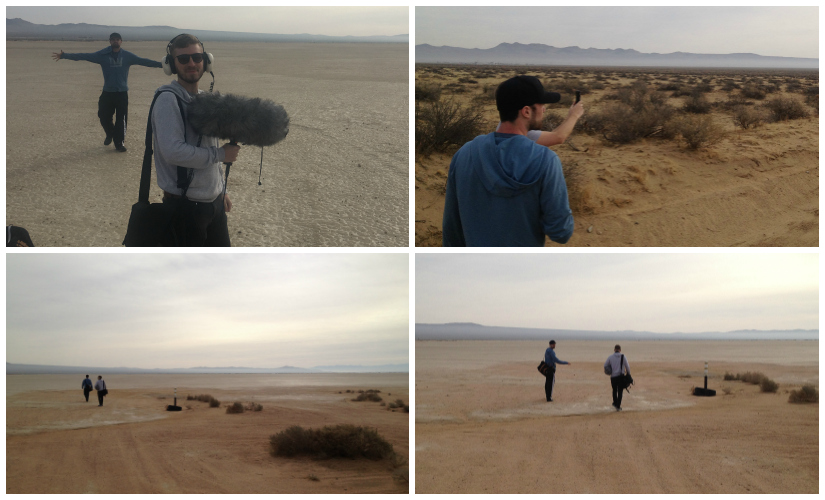
NL: We also used this trip to try and capture some exterior Foley sounds. In-game, we had various moments where Cal walks through a shallow stream with rocks in it. Being the veteran of many a childhood vacation into the wilds of stream-laden Wales (UK), the sounds we had created for the game from libraries didn’t feel real to me. So much to the amusement/incredulity of Kevin and Nick [von Kaenel], part of our quest was finding a shallow stream with rocks. The movie ranch had one which we dutifully waded around in, but we hit the jackpot in an area of the Angeles National Forest called the Devil’s Punchbowl. The stream was identical to what we had in-game and we were able to re-create exactly the sound I remembered from my childhood Wales vacations!
One of the cooler sounds we recorded with the Ambisonic mic was a starter pistol fired between two cliffs, which I could rotate later to make an interesting IR with a staggered delay from front to back.
Arguably you could probably do something similar at a Foley stage but it would be a complicated setup with running water. Plus, good exterior recordings have more natural air and perspective. We achieved it by bringing wellington boots (very important!) and then recording ourselves walking around with a mic in a Rycote (you can see the rigs we used in some of the pictures). We had one Ambisonic rig (Ambeo) and one mono (Sennheiser MKH 40) from what I remember.
Stefan Kovatchev (SK): There is a large variety of iconic sounds in the Star Wars galaxy represented by some combination of processed real world animal recordings. Recreating that grounded-yet-extraterrestrial feel in areas like Kashyyyk and The Tomb of Miktrull, for example, was important in establishing those environments as a believable part of each planet.
There is a large variety of iconic sounds in the Star Wars galaxy represented by some combination of processed real world animal recordings.
Northern mockingbirds were particularly useful to record because of the sheer variety of sounds they produce. When recorded at high sample rates, their slowed down calls work well for jungles and swamps. Something like a pair of Sennheiser MKH 8040s or Sanken CO-100Ks is ideal, but I found the LOM mikroUši to be a viable option for high frequency recording as well. I typically concealed my Sound Devices MixPre-6 under an active tree and came back after an hour or so in order to get as close to the sound source as possible without disturbing the birds. If you want to recreate something similar to the swamps of Dagobah, this is a good place to start.
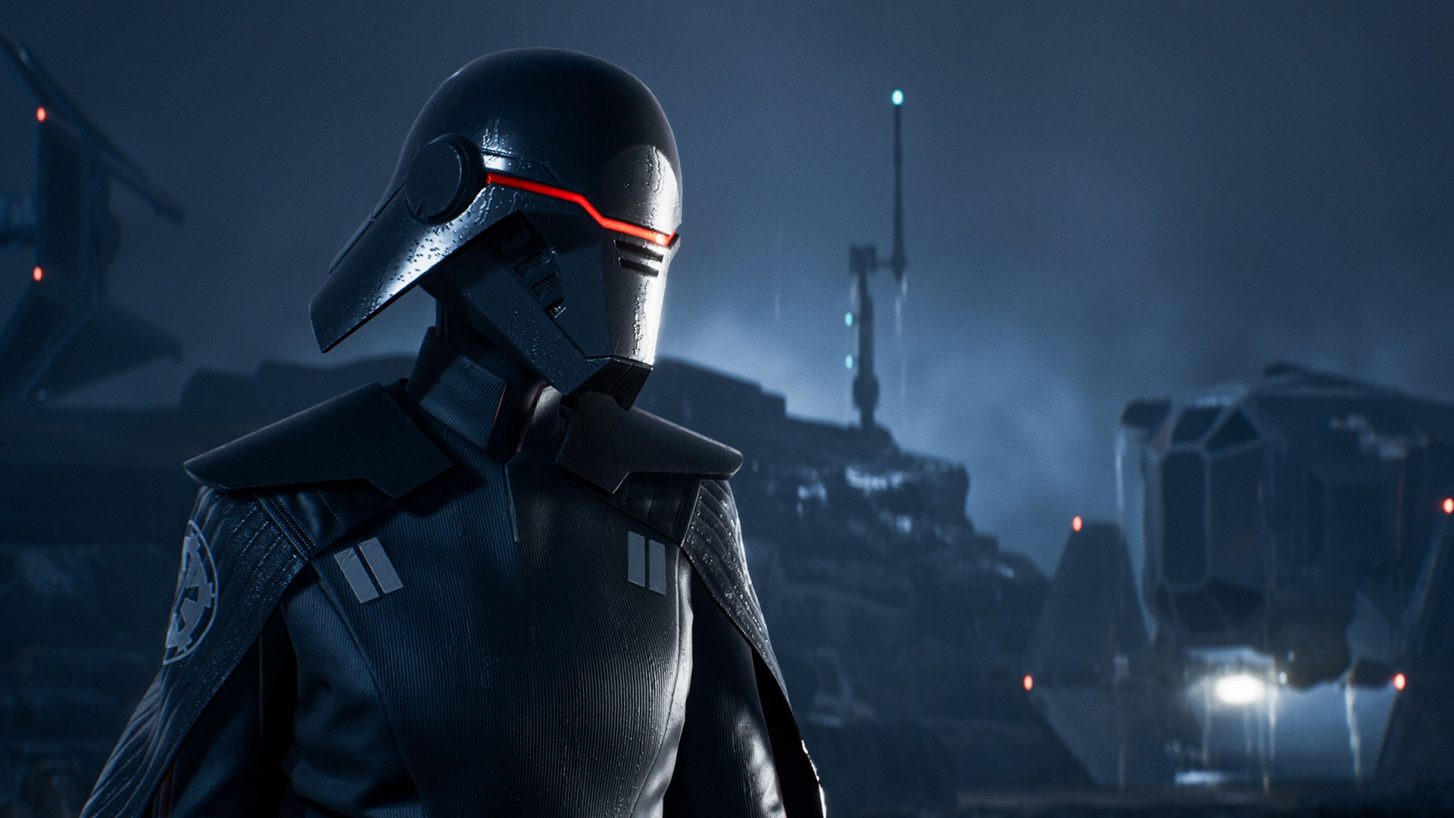
The game has lots of acrobatics — jumping, grabbing, climbing, and sliding on various surfaces in numerous environments, from navigating the outside of a moving train to climbing vines on Bogano to sliding on ice in the Windswept Ruins (before the Ice Caves). So many surfaces! Plus, gear rattles! Was that all Foley? The Foley for this game must have been incredible….
KN: This was a combination of a bunch of people, but the core was Foley, like running, jumping, climbing, etc., which was recorded at Warner Bros. and edited and perfected by Jeremy Rogers. Paxson Helgesen owned Foley tagging, as well as sound for things like Cal’s climbing claws, body falls, etc.
. I think people respond to the interactivity in these sounds. It’s fun to hear ice getting cut when a player changes angle, or the creaks of vines as they start swinging.
I took on the stuff that often required heavier scripting, like rope swinging, sliding, and falling, since it’s interactive and more implementation-intensive. I think people respond to the interactivity in these sounds. It’s fun to hear ice getting cut when a player changes angle, or the creaks of vines as they start swinging.
As far as surfaces in the game, here is the full list:
Thirty surface types: Cloth, Concrete, Dirt, Flesh, Forest, Glass, Grass, Gravel, Ice, MetalBeam, MetalGrate, MetalHollow, MetalPipe, MetalShip, MetalSolid, Mud, Rock, Rubber, SandDry, SandWet, SnowThick, SnowThin, WaterShallow, WaterDeep, WaterPuddle, WaterRocky, Web, WoodRotted, WoodThick, and WoodThin
Five foliage types: GrassLong, GrassShort, GrassDry, LeavesLarge, LeavesSmall
Two outfits: Jacket (default) and poncho
We also have a switch for when you’re walking on these surfaces when it’s raining.
What were the most challenging creatures to design? Why? How did you create their sounds?
KN: Gorgara (our large bat boss) was challenging for me, because of how many different sounds she makes. The goal was to make her sound more distinct, but to also keep consistency across her sound palette.
To help with this, we contracted Boom to record a variety of rare and exotic animals for us to use as source (tasmanian devil, hippo, walrus, etc). Gorgara is made up entirely of these recordings (processed to make her sound bigger). When too many creatures are layered together, it ends up sounding like noise. It sounds fake. By doing these custom recordings, we are able to get tons of source to work with.
When too many creatures are layered together, it ends up sounding like noise. It sounds fake. By doing these custom recordings, we are able to get tons of source to work with.
People have told me that they either love the way she sounds, or think she is annoying and they can’t wait to kill her. I actually like it when things are polarizing. Oftentimes it means that you tried to do something different, which is what you should be doing for a new creature in Star Wars!
NVK: My goal for the Shyyyo Bird was to make a creature that sounds huge and majestic, but also like a bird. Adding weight to bird-like sounds was challenging because the sounds of cooing and tweeting are generally simple high-pitched tones. I actually didn’t use a ton of bird source, just eagle and hawk screeches for some of the screams. A lot of it ended up being pig squeals processed in various ways. I actually was able to get some really nice sympathetic cooing sounds by completely de-noising a pig squeal until it was just basic tones and then pitching it into phrases. I also threw in some super pitched-down honey badger for fun.
Adding weight to bird-like sounds was challenging because the sounds of cooing and tweeting are generally simple high-pitched tones.
A big part of getting the size of the vocals right ended up being the mastering chain. It was basically a slight de-noise into multiband saturation, and four different plug-ins boosting the low-end: Waves L316, Rbass, MaxxBass, and Submarine. I also baked in a bit of delay/reverb just in-case. I ended up using this same chain for processing the Foley in order to add size to the footsteps and wing flaps.
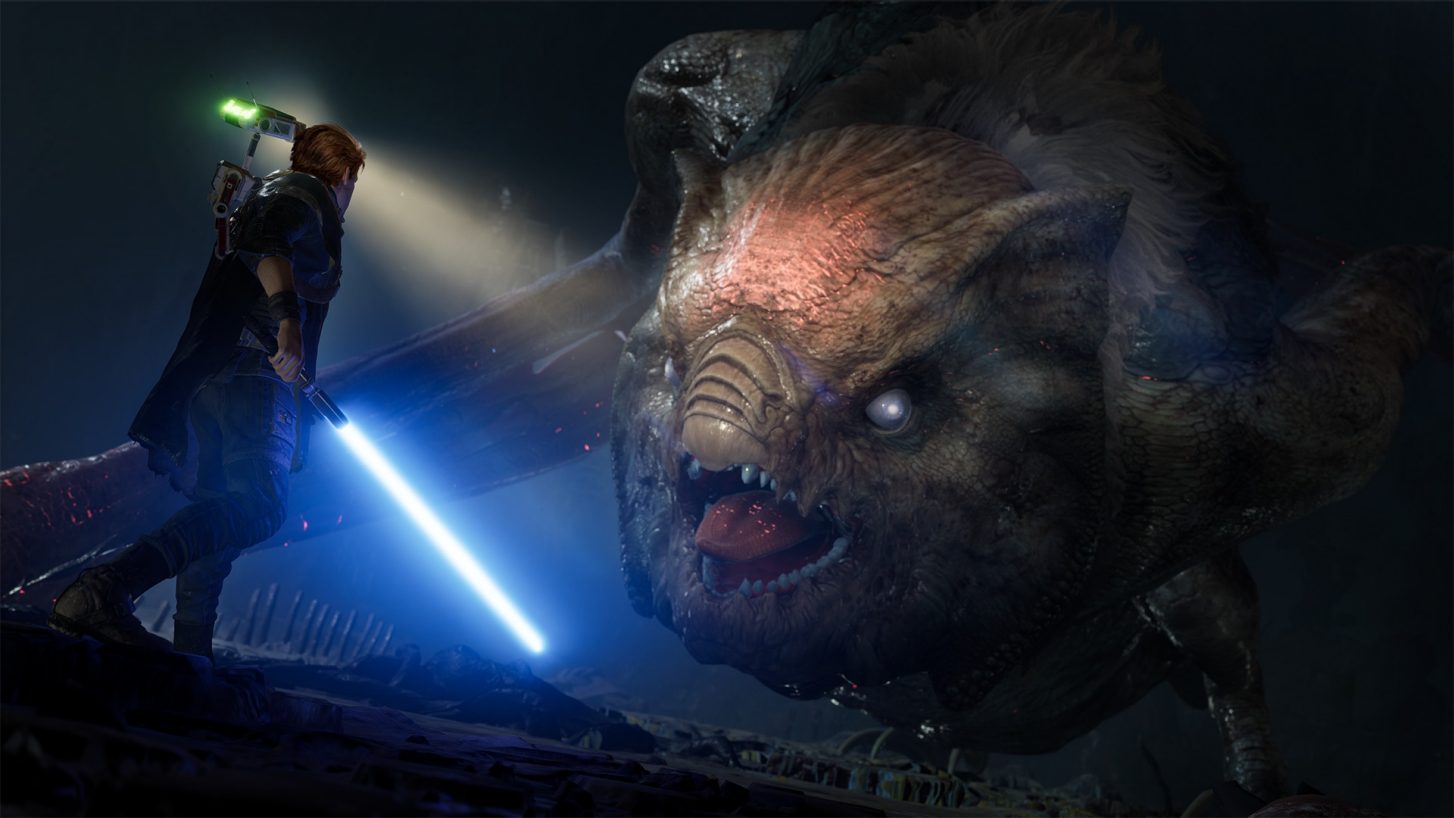
What was the most challenging weapon to design? Why? How did you create it?
KN: The Purge Trooper’s electrostaff was tough because it’s a noisy source. For this weapon, I worked off of the MagnaGuard’s electrostaff from Star Wars: Revenge of the Sith, processed it a little (Waves Reel ADT is the go-to plug for that Star Wars warm retro analogue sound), added some additional synth tonality, and then added in a bunch of distorted masking tape recordings to simulate cleaner electricity. Tape that is stretched and distorted sounds way more dangerous than going out and recording a Jacob’s Ladder or whatever.
I also really liked designing the sound for Saw Gerrera’s blaster because I FINALLY had the chance to use all of those slinky recordings I had done at the beginning of the project.
What was your favorite planet/location to design? What went into the sound there?
I made the sound of the spinning by creating a looping pad of grinding metal/stone and send it through Waves MondoMod for a tremolo effect.
NVK: The Tomb of Eilram was probably my favorite location because of all the cool puzzles and interacts. There are these giant mysterious spinning spheres that power the temple and it was a lot of fun designing them. I made the sound of the spinning by creating a looping pad of grinding metal/stone and send it through Waves MondoMod for a tremolo effect. I also made these bell tones in Reaktor which play whenever you connect a sphere to a socket. I think the sound could have gone in a completely different direction, but something about this approach just felt right. We don’t really understand the Zeffo or any of their technology, so I wanted to give it an ancient, spiritual feel. I also created some tones from organs, flutes, and my own voice which play through some of the wind tunnels. This idea came from Stig [Asmussen], our game director. He had the idea that the wind was part of a ritual of some sort and that it would flow through the temple like a giant organ.
We don’t really understand the Zeffo or any of their technology, so I wanted to give it an ancient, spiritual feel.
SK: Bracca was my favorite level to design sound for, and probably the most complicated amongst the things I worked on. There was a lot of moody, atmospheric character to play with, from scrap rats, welder droids, trash barges, to the storm ambience, and various interactable elements. There is a section of the level where Cal drifts off into sleep and has a Force hallucination while walking through this passenger train. The alien walla between the workers, the display screens and intercoms, the creaking movement of the train, and lights whooshing by while the hallucinations intensify all provided interesting opportunities for sound.
Star Wars Jedi: Fallen Order uses the UE4 game engine. Was that a good fit for the sound team? Why?
KN: Absolutely. UE is my favorite engine because of how much control you get through Blueprint. Our programmer was only part-time on audio, and had a variety of other tasks, so a lot of the audio system creation and management fell on me.
Our programmer was only part-time on audio, and had a variety of other tasks, so a lot of the audio system creation and management fell on me.
In game sound design, the implementation stage is half the battle, and we all spend at least 50 percent of our time (if not more) implementing, testing, mixing, and tuning. UE4 supports this workflow well.
In game sound design, the implementation stage is half the battle, and we all spend at least 50 percent of our time (if not more) implementing, testing, mixing, and tuning. UE4 supports this workflow well.
SK: The ability to have autonomy with the implementation was very valuable. Being able to go into a designer’s blueprint and visually follow what’s going on while playing the game was useful as well, not to mention the amount of online resources available for UE. Generally speaking, Unreal with Wwise was one of the best workflows I’ve used.
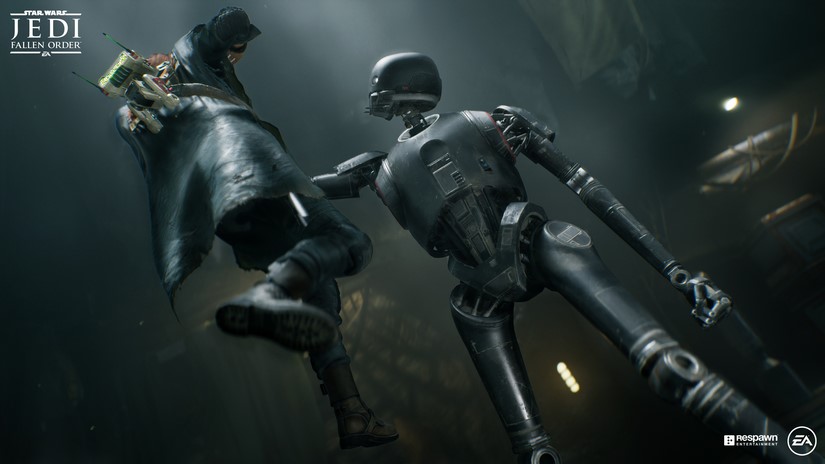
What are you most proud of in terms of sound on Star Wars Jedi: Fallen Order?
KN: The core combat. Combat finishers, Force powers, abilities, etc. I think they fit within the Star Wars aesthetic, but are stylized and unique to Jedi: Fallen Order. I also like how the Night Sister you meet on Dathomir, Merrin’s magick turned out.
From other sound designers on the team, I love the UI that Nick [von Kaenel] did, and Stefan did an amazing job bringing so many of the levels to life with sound. That train decouple sequence on Bracca sounds so clean and punchy.
NVK: The UI. I’ve already elaborated on it, but it was nice owning that aspect of the game and creating a cohesive vision for the sound.
SK: I think I’m most proud of the Imperial train in the intro. There is one section that was particularly tricky to pull off, where Cal is fighting on top of the train while going in and out of tunnels in a thunderstorm. I set up volumes on the tunnel openings to call different ambience states, while using distance switches with continuous play mode to trigger sounds for objects flying by. I also set up events for entering and exiting the tunnels, and occlusion volumes for the train cars if you happened to enter while fighting. (Credit to Kevin for the code on those components)
I set up volumes on the tunnel openings to call different ambience states, while using distance switches with continuous play mode to trigger sounds for objects flying by. I also set up events for entering and exiting the tunnels, and occlusion volumes for the train cars if you happened to enter while fighting.
I ended up placing storm emitters near every door so that if you opened a door but didn’t exit the train, you would still hear the outside ambience despite being in an occlusion volume, and muting these emitters as soon as you walked outside. I had to have all the ambiences play together while the game switched between them based on what was happening. The cut-scenes here were also a lot of fun, I’m pretty happy with how those turned out.
NL: I love the way the whole opening of the game turned out. Stefan’s attention to detail was through the roof and Kevin worked really hard on getting the in-game mix and the cinematics working seamlessly together. The result was like the best kind of action feature film ++.
In addition to what we’ve already mentioned, I want to call out some of the creatures developed by the team here as real highlights for me: Kevin’s epic Gorgara bat and Nick [von Kaenel]’s powerful and gorgeous Shyyyo bird sounds. Then, of course, the lovable droid BD-1 by Ben Burtt, Nick [von Kaenel] and dialogue designer Nick Friedmann. There are so many amazing sounds, it feels wrong to only call out a few of them!



